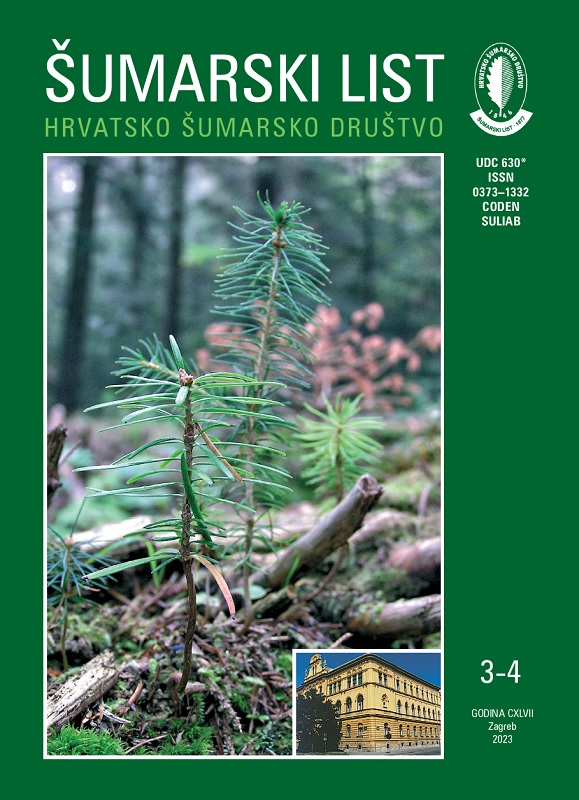
broj: 3-4/2023
pdf (11,3 MB) |
|
||||||||||||||
| RIJEČ UREDNIŠTVA | ||
| Uredništvo | ||
| On the occasion of March 21st, International Day Of Forests pdf HR EN | 105 | |
| IZVORNI ZNANSTVENI ČLANCI | ||
| Aydn Kahriman, Abdurrahman Şahin, Turan Sönmez, Mehmet Yavuz | UDK 630* 622+228 (001) https://doi.org/10.31298/sl.147.3-4.1 | |
| Growth models for natural stands of Calabrian pine in the central Mediterranean region of Türkiye pdf HR EN | 107 | |
| Sercan Gulci, Neşe Gulci, Dalia Abbas, Hasan Serin, Kvanç Yuksel | UDK 630* 831+360 (001) https://doi.org./10.31298/sl.147.3-4.2 | |
| Evaluating the carbon monoxide mission from chainsaw exhaust outlet pdf HR EN | 121 | |
| Summary In many countries, two-stroke chainsaws have been actively used in forest operations. Chainsaw operators are exposed to harmful gases and particulates generated by the exhaust of the two-stroke hand-held chainsaw. In this study, carbon monoxide (CO) parts per million (ppm) exposure of operators working with a chainsaw at 1900-2000 revolutions per minute (rpm) was investigated by mixing oil-fuel at a ratio of Society of Automotive Engineers (SAE) 10W motor oil (2.5%) and 95-octane unleaded gasoline. To investigate the presence of CO at a short distance, the relationship between exposure time and distance from the source were divided into groups. The result of the statistical analysis has shown that the average amount of CO emitted from the chainsaw was 1683 ppm at a distance of 0 (±4 cm) cm, 343.6 ppm at a 10 cm distance, 252.3 ppm at a 20 cm distance and 86.5 ppm at a 30 cm distance. The analysis of variance, according to the distance, has shown the amount of CO (ppm) to be statistically significant (p <0.05). If the chainsaw operator is working very close to the chainsaw, CO exposure will be observed, which translates to a negative impact on their health and work efficiency. Therefore, training should be conducted to increase the awareness of the proximity to the chainsaw and the operators and the importance of using personal protective equipment. In addition to training support, the use of the new generation of chainsaw engines should also be encouraged and promoted to minimize CO emissions. Key words: Forestry; timber production; two-stroke gasoline engine; emissions exposure; carbon monoxide; operator health | ||
| Bilal Çetin | UDK 630* 630+232.3 (001) https://doi.org/10.31298/sl.147.3-4.3 | |
| The effect of altitude and closed cone (seed) age on germination in red pine (Pinus brutia Ten.) pdf HR EN | 129 | |
| PREGLEDNI ČLANCI | ||
| Igor Poljak, Katarina Tumpa, Antonio Vidaković, Mirna Ćurković-Perica, Marin Ježić, Zlatko Šatović, Zlatko Liber, Marilena Idžojtić | UDK 630*+630+165+907 https://doi.org/10.31298/sl.147.3-4.4 | |
| Conservation and management of sweet chestnut genetic resources pdf HR EN | 137 | |
| Jasnica Medak, Ivana Sirovica, Joso Vukelić | UDK 630*228+332+653 https://doi.org/10.31298/sl.147.3-4.5 | |
| Forest clearing typology pdf HR EN | 147 | |
| Ana Šujica, Martina Obradović, Mia Lovreković, Veronika Šušnjara, Dominik Paparić, Željko Španjol, Boris Dorbić | UDK 630* 652 https://doi.org/10.31298/sl.147.3-4.6 | |
| Valorization of significant trees in Šibenik-Knin County pdf HR EN | 155 | |


